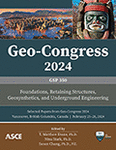Geocell-Reinforced Capping Layer in Rail Tracks Subjected to Cyclic Loading: Laboratory and Numerical Modeling Study
Publication: Geo-Congress 2024
ABSTRACT
This research investigates the behavior of geocell-reinforced capping layers in ballasted tracks subjected to cyclic loading. Large-scale laboratory testing and numerical modeling techniques were employed. The cyclic tests applied a 25-t axle load under frequencies ranging from 10 to 30 Hz. The geocell-reinforced capping layers were modeled using the discrete element method. The geocell structure was simulated by bonding small balls to build a realistic geometry and shape. Model parameters were calibrated based on tensile and bending tests performed on the geocell material. The DEM simulations accurately represented the irregular shape of the capping aggregates using bonded circular particles. The findings indicated that the geocell effectively reduced both vertical and lateral displacements of the capping layer. The DEM analysis provided valuable insights into the contact force chain distributions within the capping assembly.
Get full access to this article
View all available purchase options and get full access to this chapter.
REFERENCES
Astaraki, F., M. Esmaeili, and M. Reza Roozbini. (2022). Influence of geocell on bearing capacity and settlement of railway embankments: an experimental study. Geomech. Geoengin., 17(2), 630–646.
Banerjee, L., S. Chawla, and S. K. Dash. (2020). Application of geocell reinforced coal mine overburden waste as subballast in railway tracks on weak subgrade. Constr. Build. Mater., 265, 120774.
Bathurst, R. J., and G. P. Raymond. (1987). Geogrid reinforcement of ballasted track. Transp. Res. Rec. 1153: 8–14.
Biabani, M. M., B. Indraratna, and N. T. Ngo. (2016). Modelling of geocell-reinforced subballast subjected to cyclic loading. Geotext. Geomembr. 44(4): 489–503.
Biabani, M. M., N. T. Ngo, and B. Indraratna. (2016). Performance evaluation of railway subballast stabilised with geocell based on pull-out testing. Geotext. Geomembr. 44(4): 579–591.
Bian, X., W. Li, Y. Qian, and E. Tutumluer. (2020). Analysing the effect of principal stress rotation on railway track settlement by discrete element method. Géotechnique. 70(9): 803–821.
Bolton, M. D., Y. Nakata, and Y. P. Cheng. (2008). Micro- and macro-mechanical behaviour of DEM crushable materials. Géotechnique. 58(6): 471–480.
Brown, S. F., J. Kwan, and N. H. Thom. (2007). Identifying the key parameters that influence geogrid reinforcement of railway ballast. Geotext. Geomembr. 25(6): 326–335.
Cui, L., and C. O’Sullivan. (2006). Exploring the macro- and micro-scale response of an idealised granular material in the direct shear apparatus. Géotechnique. 56(7): 455–468.
Cundall, P. A., and O. D. L. Strack. (1979). A discrete numerical model for granular assemblies. Géotechnique. 29(1): 47–65.
Esveld, C. (2014). Modern railway track, MRT Press, The Netherlands.
Indraratna, B., M. M. Biabani, and S. Nimbalkar. (2015). Behavior of Geocell-Reinforced Subballast Subjected to Cyclic Loading in Plane-Strain Condition. J Geotech Geoenviron. 141(1): 04014081.
Indraratna, B., and T. Ngo. (2018). Ballast Railroad Design: Smart-Uow Approach, CRC Press.
Indraratna, B., Q. Sun, N. T. Ngo, and C. Rujikiatkamjorn. (2017). Current research into ballasted rail tracks: model tests and their practical implications. Aust. J. Struct. Eng. 1–17.
Leshchinsky, B., and H. I. Ling. (2013). Numerical modeling of behavior of railway ballasted structure with geocell confinement. Geotext. Geomembr. 36: 33–43.
Luo, Z., C. Zhao, X. Bian, and Y. Chen. (2023). Discrete element analysis of geogrid-stabilized ballasted tracks under high-speed train moving loads. Comput Geotech. 159.
McDowell, G. R., and H. Li. (2016). Discrete element modelling of scaled railway ballast under triaxial conditions. Granul. Matter. 18(3): 66.
Ngo, N. T., B. Indraratna, C. Rujikiatkamjorn, and M. M. Biabani. (2016). Experimental and Discrete Element Modeling of Geocell-Stabilized Subballast Subjected to Cyclic Loading. J Geotech Geoenviron. 142(4): 04015100.
Selig, E. T., and J. M. Waters. (1994). Track geotechnology and substructure management, Thomas Telford, London.
Tran, K. M., H. H. Bui, M. Sánchez, and J. Kodikara. (2020). A DEM approach to study desiccation processes in slurry soils. Comput Geotech. 120: 103448.
Tran, V. D. H., M. A. Meguid, and L. E. Chouinard. (2013). A finite–discrete element framework for the 3D modeling of geogrid–soil interaction under pullout loading conditions. Geotext. Geomembr. 37: 1–9.
Tutumluer, E., H. Huang, and X. Bian. (2012). Geogrid-Aggregate Interlock Mechanism Investigated through Aggregate Imaging-Based Discrete Element Modeling Approach. Int. J. Geomech. 12(4): 391–398.
Zhang, X., C. Zhao, and W. Zhai. (2019). Importance of load frequency in applying cyclic loads to investigate ballast deformation under high-speed train loads. Soil Dyn. Earthq. Eng. 120: 28–38.
Information & Authors
Information
Published In
History
Published online: Feb 22, 2024
Authors
Metrics & Citations
Metrics
Citations
Download citation
If you have the appropriate software installed, you can download article citation data to the citation manager of your choice. Simply select your manager software from the list below and click Download.
